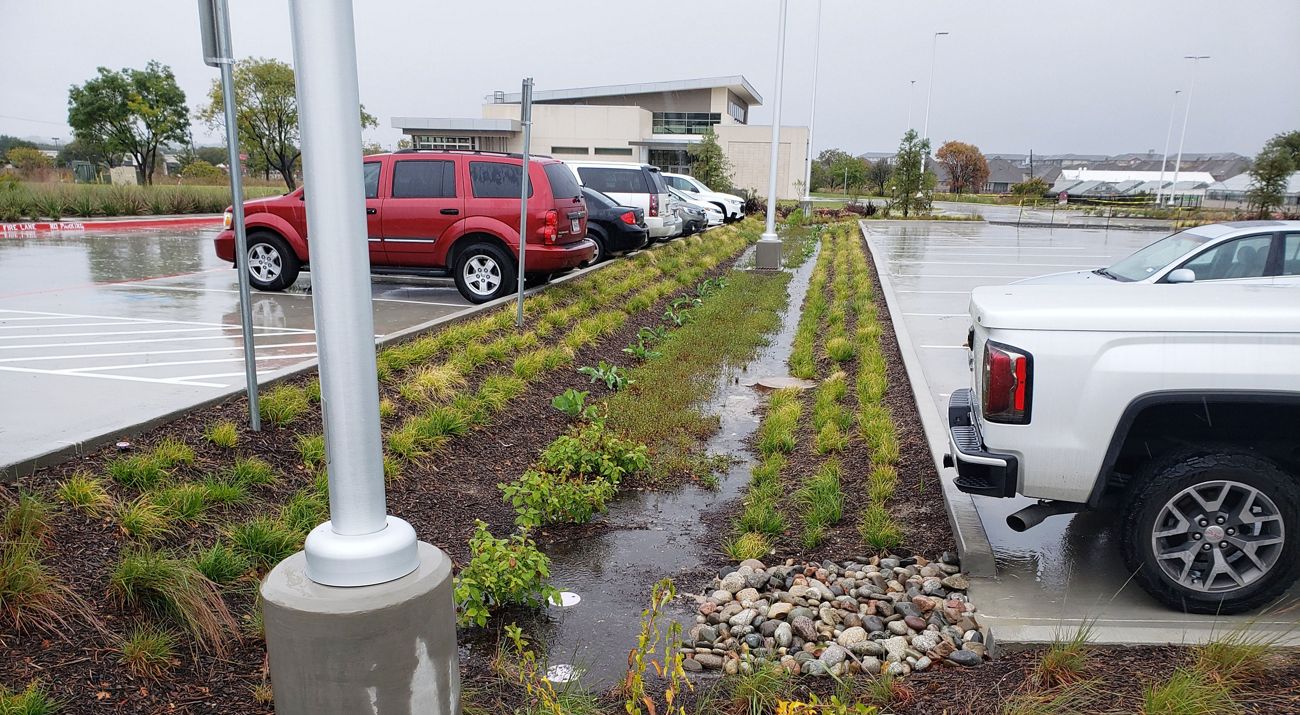
New Research: Green Stormwater Infrastructure Can Improve Flood Resilience in Dallas
In a new study, The Nature Conservancy and Texas A&M AgriLife highlight the value of nature for urban flood management
Media Contacts
-
Claire Everett
Email: claire.everett@TNC.ORG
The Nature Conservancy (TNC) and Texas A&M AgriLife (AgriLife), in collaboration with the City of Dallas and the Trust for Public Land, today announced new findings from a joint report that indicates where “green” stormwater infrastructure can most effectively enhance urban flood resilience within the City of Dallas, Texas. Green stormwater infrastructure (GSI) uses engineered plant and soil systems that mimic nature’s natural ability to absorb and filter water. The study considers capacity, cost, and the future impacts of climate change and identifies substantial opportunities and recommendations for improved stormwater management practices with GSI.
Dallas is experiencing more frequent and more intense rain events—a pattern that is predicted to continue as our climate changes. Dallas-Fort Worth is the fastest growing metropolitan area in the United States. Much of the region’s natural land cover is being converted to human-made surfaces—like asphalt and concrete, which do not absorb rainfall. Like other U.S. cities, the drainage needs in many areas of Dallas have outgrown the capacity of its existing stormwater drainage system. As Dallas-Fort Worth’s development continues, weather events like flooding will further impact its rapidly growing population.
There is a critical need and an opportunity to identify cost-effective ways of approaching flooding and water quality challenges in Dallas. Natural solutions like GSI can play an important role in enhancing flood resilience in the DFW metroplex.
“This analysis provides important data on how and where decision-makers and investors in Dallas can best leverage the benefits of nature to reduce urban flooding,” said Dr. Kathy Jack, Dallas Healthy Cities Program Director for The Nature Conservancy in Texas. “When considered as a part of comprehensive and stormwater planning efforts, and site and neighborhood level designs, GSI can contribute to multiple, stacked benefits—for people and nature.”
Notable findings from this new research include:
- Climate change is predicted to increase the number and the overall impacts of stormwater “system hotspots”—locations where the drainage network is undersized and likely to contribute to inlet overflows and areal flooding during rain events. For the storms modeled in this study, climate change resulted in an average increase of 26% in the number of drainage system hotpots, compared to current conditions.
- GSI was found to reduce overflows for all storms modeled by 17-31% and to delay peak flows potentially reducing areal flooding, creek flows, and overbank flooding.
- Substantial, cost-effective opportunities have been identified for GSI to improve stormwater management in Dallas, particularly within Joes’ Creek, Cedar Creek, and Five Mile Creek Watersheds, as well as portions of the White Rock Watershed.
- GSI was found to cost 77% less than upgrading to gray infrastructure alone to meet modeled overflows; a combination of green and gray provides the maximum cost-effective benefits.
- Of the systems studied, bioretention areas—particularly in parking lots—offer the greatest opportunities for community impacts. Bioretention areas can capture, treat, and infiltrate portions of surface stormwater runoff through engineered soil, before draining to the gray stormwater network. Rain gardens and cisterns were also found to offer substantial distributed opportunities for health and resilience.
“With changing rainfall patterns, it is crucial that cities across the U.S. evaluate the capacity of their drainage networks to handle current and future rainfall events and address shortcomings using resilient, nature-based solutions such as green stormwater infrastructure,” explains Dr. Fouad Jaber, Texas A&M University Professor.
The study provides key science for planners, policymakers, and other community leaders to consider GSI as a valuable tool for flood-risk reduction, water quality improvement, and enhanced biodiversity—all while increasing safety and conserving funds.
“This new research on Green Stormwater Infrastructure is very important to the City of Dallas,” says Terry Lowery, Director for Dallas Water Utilities. “The study will help the City identify cost-effective green infrastructure opportunities to improve urban flood management and water quality.”
“In our growing city, heavy rains and extreme weather pose an even greater risk to safety and infrastructure,” adds Robert Kent, Texas State Director at Trust for Public Land. “This report provides critical research and data showing how well-designed parks and green spaces can help address this growing need.”
“Balancing the growth of cities with conservation requires thoughtful, collaborative planning,” says Dr. Jack. “Nature can improve overall community health and resilience when integrated into the fabric of our cities.”
This study was accomplished through a partnership between The Nature Conservancy in Texas and Texas A&M AgriLife (AgriLife), in collaboration with Dallas Water Utilities (DWU), the City of Dallas Office of Environmental Quality & Sustainability (OEQS), and The Trust for Public Land (TPL). The analysis was funded by Lyda Hill Philanthropies.
Download the Report
The Nature Conservancy is a global conservation organization dedicated to conserving the lands and waters on which all life depends. Guided by science, we create innovative, on-the-ground solutions to our world’s toughest challenges so that nature and people can thrive together. We are tackling climate change, conserving lands, waters and oceans at an unprecedented scale, providing food and water sustainably and helping make cities more resilient. The Nature Conservancy is working to make a lasting difference around the world in 83 countries and territories (39 by direct conservation impact and 44 through partners) through a collaborative approach that engages local communities, governments, the private sector, and other partners. To learn more, visit nature.org or follow @nature_press on X.